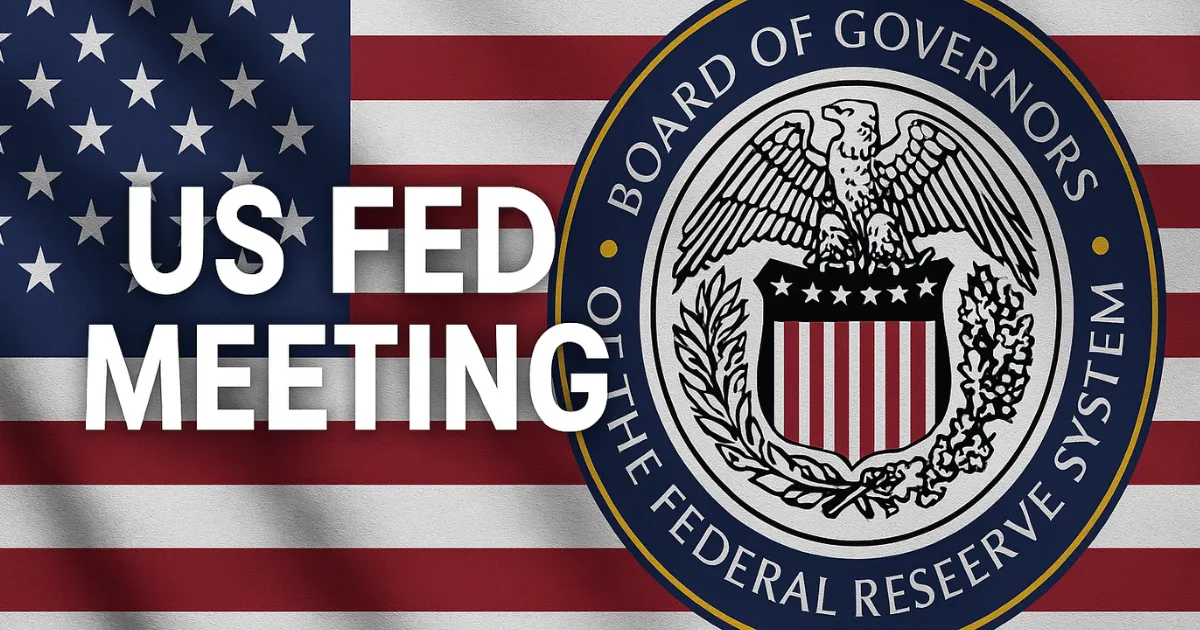US Fed Meeting 2025 LIVE:- Are you anxious about how the US Fed Meeting 2025 LIVE will shape your financial future? With the Federal Reserve, under Chair Jerome Powell, poised to announce a 25 basis point (bps) rate cut in September 2025, the economic landscape is shifting. This decision influences mortgages, stock markets, and small business loans, impacting everyone from investors to everyday consumers. This comprehensive, SEO-optimized article dives into seven positive signals from the Fed’s September 2025 meeting, offering clear, actionable insights backed by data, real-world examples, and expert analysis.
We’ll explore what the rate cut means for your finances and the broader economy, ensuring you’re equipped to navigate the changes ahead. Whether you’re planning investments or managing debt, this guide will help you stay ahead of the curve.
The Significance of the US Fed Meeting 2025 LIVE
The US Fed Meeting 2025 LIVE, conducted by the Federal Open Market Committee (FOMC), is a cornerstone of U.S. monetary policy. Held in September 2025, this meeting determines the federal funds rate, which sets the tone for borrowing costs nationwide. The anticipated 25 bps cut signals a shift from the Fed’s previous high-rate stance to combat inflation, now moving toward stimulating economic growth. This decision is critical for investors, homeowners, and businesses, as it influences everything from mortgage rates to corporate earnings.
US Fed Meeting: Economic Context Leading to September 2025
The U.S. economy has navigated turbulent waters since 2022’s inflation peak. By September 2025, inflation has stabilized at 2.02%, per the Truflation Index, aligning with the Fed’s 2% target. However, challenges persist: unemployment climbed to 4.2% in August 2025, and housing starts fell 8.5% to 1.307 million units, reflecting high borrowing costs. The 25 bps cut aims to address these issues while maintaining price stability, balancing the Fed’s dual mandate of maximum employment and stable prices.
US Fed Meeting: Decoding the 25 bps Rate Cut
A 25 bps rate cut lowers the federal funds rate, reducing the cost of borrowing for consumers and businesses. This encourages spending, investment, and hiring but is a cautious step to avoid reigniting inflation. Unlike a larger 50 bps cut, this move prioritizes sustainable growth. Understanding its implications is key to making informed financial decisions in 2025.
7 Positive Signals from the US Fed Meeting 2025 LIVE
The September 2025 meeting offers several encouraging signs for the economy. Below, we explore seven key signals, their implications, and what they mean for you.
1. Inflation Stabilized Near 2%
After aggressive rate hikes in 2022–2023, inflation has cooled to 2.02%, per the Truflation Index, aligning with the Fed’s target. This stability allows the Fed to shift focus from inflation control to economic growth, with the 25 bps cut signaling confidence in sustained price stability.
- Why It Matters: Stable inflation preserves purchasing power, benefiting consumers and businesses.
- Impact: Lower borrowing costs could drive retail spending and business investment.
- Example: In 2020, stable inflation post-rate cuts boosted consumer confidence, increasing retail sales by 7.5%.
2. Housing Market Poised for Recovery
High mortgage rates, at 6.8% in August 2025, have stifled housing starts, down 8.5% to 1.307 million units. A 25 bps cut could lower rates to 6.4%–6.6%, making homebuying more affordable and stimulating construction activity.
- Real-World Impact: In 2020, rate cuts dropped mortgage rates to 2.7%, spurring a 22% surge in home sales.
- What’s Next: Housing demand may rise in Q4 2025, benefiting builders, realtors, and buyers.
- Tip: Compare mortgage offers on Freddie Mac to secure the best rates.
3. Stock Market Optimism
Stock futures, including the Dow Jones Industrial Average (up 0.05% pre-meeting), reflect bullish sentiment. Lower rates reduce corporate borrowing costs, boosting earnings and favoring growth stocks in tech and consumer discretionary sectors.
- Case Study: A 50 bps cut in September 2024 lifted the S&P 500 by 4% within a month.
- Outlook: Investors may see gains in real estate and small-cap stocks, with potential for 3.5%–4% S&P 500 growth in Q4 2025.
- Strategy: Diversify portfolios with index funds to manage volatility.
4. Support for the Labor Market
Unemployment rose to 4.2% in August 2025, prompting the Fed to stimulate hiring. Lower rates reduce business financing costs, encouraging payroll expansion, particularly among small firms.
- Data Point: Post-2020 rate cuts, small business hiring increased 12% annually.
- Benefit: Job growth could stabilize unemployment at 4.0%–4.1% by Q4 2025.
- Example: A 2021 rate cut led to 500,000 new jobs in small businesses within six months.
5. Boosting Consumer Confidence
Lower interest rates reduce costs for car loans, credit cards, and personal loans, enhancing consumer confidence. This drives spending in retail and services, critical for GDP growth.
- Historical Context: Post-2020 cuts, consumer spending grew 7.5%, supporting economic recovery.
- Projection: Retail spending may rise 3.2%–3.5% in Q4 2025.
- Action: Refinance high-interest debt to capitalize on savings.
6. Alignment with Global Economies
The Fed’s cut aligns with global easing trends, such as the European Central Bank’s 2024 cuts, which boosted Eurozone equities by 3%. This fosters global stability and encourages capital flows to emerging markets.
- Implication: A weaker dollar could boost U.S. exports, benefiting manufacturers.
- Global Outlook: Emerging markets may see increased investment, supporting trade.
- Example: Post-2019 cuts, global capital flows to emerging markets rose 5%.
7. Transparent Fed Communication
The Fed’s 2025 monetary policy review emphasizes clear communication. Powell’s press conference and the Summary of Economic Projections (SEP) will provide insights into future rate expectations, reducing market uncertainty.
- Why It’s Positive: Transparency minimizes volatility, aiding investor confidence.
- Key Focus: The SEP’s “dot plot” will guide 2026 rate forecasts.
- Resource: Follow live updates on FederalReserve.gov.
Comparing Rate Cut Scenarios: 25 bps vs. 50 bps
To understand the 25 bps cut’s impact, let’s compare it to a hypothetical 50 bps cut.
| Factor | 25 bps Cut | 50 bps Cut |
|---|---|---|
| Borrowing Costs | Gradual reduction in loan/mortgage rates | Sharp drop, faster borrower relief |
| Inflation Risk | Low, cautious approach | Higher, potential inflation surge |
| Stock Market | Moderate bullish sentiment | Strong rally, higher volatility |
| Economic Growth | Steady, sustainable stimulus | Aggressive, risk of overheating |
| Consumer Impact | Incremental savings on loans | Significant savings, rapid spending boost |
Analysis: The 25 bps cut balances growth and inflation control, minimizing risks of economic overheating.
US Fed Meeting: Economic Projections Post-Rate Cut
The rate cut will influence key economic indicators in Q4 2025:
| Indicator | Pre-Cut (Aug 2025) | Post-Cut (Q4 2025) |
|---|---|---|
| Federal Funds Rate | 5.25%–5.5% | 5.0%–5.25% |
| Mortgage Rates | 6.8% | 6.4%–6.6% |
| Unemployment Rate | 4.2% | 4.0%–4.1% |
| S&P 500 Growth | 2.1% (YTD) | 3.5%–4% (Q4) |
| Consumer Spending | 2.8% (annualized) | 3.2%–3.5% |
Source: Projections based on historical Fed data and market trends.
What’s Next After the US Fed Meeting 2025 LIVE?
The 25 bps cut is a stepping stone in the Fed’s 2025 strategy. Here’s what to anticipate:
1. Powell’s Press Conference Insights
Powell’s post-meeting remarks will clarify the Fed’s outlook for 2025–2026. The SEP’s “dot plot” will project future rate cuts, likely two or three in 2025. Investors and analysts will parse these comments for hints on pacing. Real-time updates on FederalReserve.gov are essential for staying informed.
2. Market Reactions and Opportunities
Markets will react swiftly to the cut. Growth stocks, real estate, and small-cap indices may rally, while bond yields could dip. The CBOE Volatility Index (VIX) will indicate market sentiment. Investors should monitor tech and consumer sectors for short-term gains.
3. Evolution of Monetary Policy Framework
The Fed’s 2025 policy review, completed in August, reaffirmed its 2% inflation target and commitment to periodic updates. This ensures adaptability to economic shifts, such as potential supply chain disruptions or geopolitical tensions affecting trade.
4. Global Economic Ripple Effects
Lower U.S. rates may weaken the dollar, boosting exports but raising import costs. Emerging markets could see capital inflows, as seen post-2019 cuts when investments rose 5%. This supports global trade but requires monitoring for inflation risks.
5. Sector-Specific Impacts
- Housing: Lower mortgage rates will spur demand, benefiting realtors and construction firms.
- Retail: Increased consumer spending will drive sales, particularly in holiday seasons.
- Technology: Cheaper financing will fuel innovation and stock gains.
Preparing for the Rate Cut: Actionable Steps
- Investors: Rebalance portfolios toward growth sectors like tech and real estate. Consider index funds for diversification.
- Homebuyers: Shop for mortgages as rates fall; use Freddie Mac to compare offers.
- Business Owners: Explore low-cost loans, such as SBA options, to fund expansion or hiring.
- Consumers: Refinance high-interest debt, like credit cards, to reduce monthly payments.
For deeper insights, read our posts on Investment Strategies for 2025 and Managing Debt in a Low-Rate Economy.
FAQ Section
1. What is the US Fed Meeting 2025 LIVE?
The US Fed Meeting 2025 LIVE refers to the Federal Open Market Committee’s (FOMC) September 2025 meeting, a pivotal event where the Federal Reserve sets the federal funds rate, influencing borrowing costs across the economy. This meeting, led by Chair Jerome Powell, is expected to announce a 25 bps rate cut, reflecting a shift toward stimulating growth after years of high rates to combat inflation. With inflation at 2.02% (Truflation Index) and unemployment at 4.2%, the cut aims to boost housing, hiring, and spending. The live event, including Powell’s press conference and the Summary of Economic Projections (SEP), provides real-time insights into the Fed’s strategy.
For investors, homeowners, and businesses, this meeting shapes financial planning, from mortgage rates to stock investments. Staying updated via FederalReserve.gov helps you understand the Fed’s next steps and their impact on your finances. Whether you’re refinancing a loan or investing in stocks, this meeting’s outcomes are critical for making informed decisions in a dynamic economy.
2. Why is the 25 bps rate cut significant?
US Fed Meeting: The 25 bps rate cut lowers the federal funds rate, reducing borrowing costs for consumers and businesses. With inflation stable at 2.02%, the Fed is confident in easing policy to address economic challenges, like a 4.2% unemployment rate and an 8.5% drop in housing starts. This cut makes loans, mortgages, and credit cards more affordable, potentially saving consumers thousands. For example, a $300,000 mortgage at 6.4% versus 6.8% saves about $50 monthly. Businesses benefit from cheaper financing, encouraging expansion and hiring, as seen post-2020 when small business loans rose 15%.
Unlike a 50 bps cut, this cautious approach minimizes inflation risks, ensuring sustainable growth. Markets, particularly tech and real estate, may rally, as evidenced by a 4% S&P 500 gain after the 2024 cut. Consumers and investors should monitor Powell’s remarks for future rate clues and act swiftly to refinance or invest, leveraging platforms like Freddie Mac for optimal rates.
3. How will the rate cut affect the stock market?
A 25 bps rate cut typically boosts stock markets by lowering corporate borrowing costs, enhancing earnings. Growth stocks in tech and consumer discretionary sectors often lead gains, as seen in 2024 when a 50 bps cut drove a 4% S&P 500 increase in a month. In September 2025, Dow futures rose 0.05% pre-meeting, signaling optimism. However, volatility may spike if Powell’s remarks suggest fewer future cuts, as markets crave clarity. Investors should focus on real estate and small-cap stocks, which thrive in low-rate environments.
Diversifying via index funds mitigates risks, while monitoring the CBOE Volatility Index (VIX) gauges market sentiment. Post-cut, S&P 500 growth is projected at 3.5%–4% in Q4 2025. Long-term success hinges on the Fed’s 2026 outlook, so staying informed via live updates is crucial. Investors can capitalize on short-term rallies by rebalancing portfolios now, ensuring alignment with growth opportunities in a dynamic market.
4. What does the rate cut mean for mortgage rates?
Mortgage rates, at 6.8% in August 2025, are expected to fall to 6.4%–6.6% post-cut, making homebuying and refinancing more affordable. Housing starts dropped 8.5% to 1.307 million units, reflecting high-rate pressures. The 25 bps cut could revive demand, as seen in 2020 when rates fell to 2.7%, boosting sales 22%. For a $400,000 mortgage, a 0.4% rate drop saves about $80 monthly, totaling $28,800 over 30 years. Homebuyers should compare rates on Freddie Mac and lock in offers early.
Refinancing existing loans can also yield significant savings. Builders may increase projects, boosting housing supply and stabilizing prices. Monitoring market trends and acting swiftly will help buyers secure lower rates. The cut’s impact extends beyond housing, supporting related sectors like construction and real estate, which could see job growth and investment opportunities in Q4 2025.
5. How will small businesses benefit from the rate cut?
Small businesses gain from lower borrowing costs, enabling investment in equipment, hiring, or expansion. With unemployment at 4.2%, the 25 bps cut supports job creation, as seen post-2020 when small business hiring rose 12%. A $100,000 loan at 5% versus 5.5% saves $500 annually in interest, freeing up capital for growth. Increased consumer spending, projected at 3.2%–3.5% in Q4 2025, boosts demand for small business services. Owners should explore SBA loans or local credit options to leverage lower rates.
For example, a retail shop could finance inventory for the holiday season, capitalizing on rising sales. However, businesses must monitor inflation risks, as rising costs could offset gains. Staying proactive with loan applications and market analysis ensures small businesses maximize benefits. The cut’s ripple effects, like stronger consumer confidence, create a favorable environment for growth, but strategic planning is key to sustaining momentum.
6. What are the risks of the 25 bps rate cut?
While the 25 bps cut stimulates growth, it risks reigniting inflation if demand surges too quickly. Inflation, at 2.02%, is stable, but external factors like tariffs or supply chain issues could push prices up, as seen in 2022’s inflation spike. Markets may also face volatility if Powell signals a slower 2026 easing pace, potentially unsettling investors. Businesses and consumers must avoid over-leveraging, as rising rates later could increase debt burdens. The Fed’s cautious approach mitigates these risks, but monitoring data like consumer spending and inflation reports is crucial.
For example, a 2023 rate hike cycle showed how quickly costs can escalate without balance. Diversifying investments and maintaining savings buffers protect against uncertainties. Powell’s press conference will offer clues on navigating these risks, guiding financial planning. Staying informed via FederalReserve.gov helps anticipate shifts and adjust strategies to balance growth and stability in a dynamic economy.
7. How can consumers prepare for the rate cut?
Consumers can capitalize on the 25 bps cut by refinancing high-interest debt, like credit cards or auto loans, to lower payments. With mortgage rates expected to drop to 6.4%–6.6%, refinancing or buying homes becomes more affordable. Post-2020 cuts, consumer spending rose 7.5%, and a similar Q4 2025 boost (3.2%–3.5%) is likely. For example, refinancing a $20,000 car loan from 7% to 6.5% saves $100 yearly. Checking credit scores ensures access to the best rates. Budgeting for potential cost increases, as demand rises, is wise.
Comparing loan offers from banks and credit unions maximizes savings. Following FederalReserve.gov keeps consumers informed on further cuts. Acting swiftly to lock in rates and planning for increased spending opportunities, like holiday shopping, will help consumers benefit. Building a financial cushion and prioritizing debt reduction ensure long-term stability in this low-rate environment.
Conclusion
The US Fed Meeting 2025 LIVE marks a turning point, with a 25 bps rate cut signaling optimism for economic growth. The seven positive signals—stable inflation, housing recovery, stock market gains, labor support, consumer confidence, global alignment, and transparent communication—offer a roadmap for 2025. As Jerome Powell guides the Fed’s strategy, investors, homeowners, and businesses must act now to leverage lower rates. Refinance debt, explore investment opportunities, or plan for expansion to stay ahead. Share your thoughts in the comments, subscribe to our newsletter for more updates. How will you navigate the Fed’s next steps?






